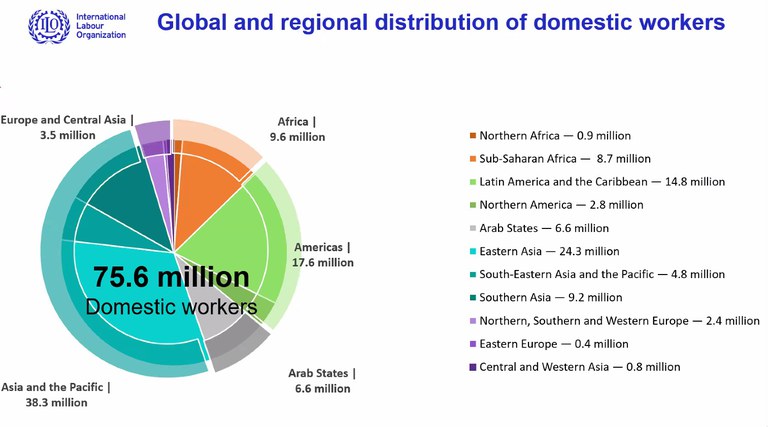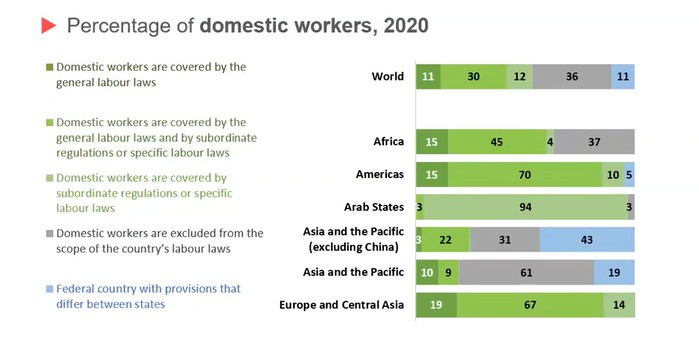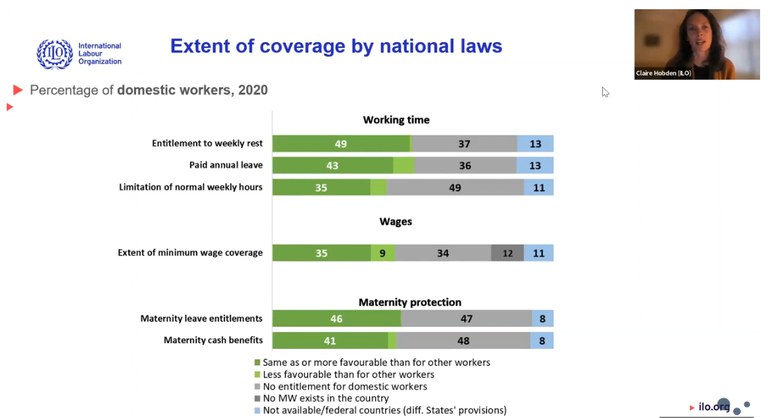THE CONTEXT
The number of digital labor platforms has multiplied by five in just the last ten years. The Covid-19 pandemic has further accelerated the digitalisation of the workplace and the expansion of the gig economy across different sectors. According to the National Domestic Workers Alliance in the United States, domestic workers are the “original gig workers”. They are characterized for having multiple jobs or gigs with multiple employers at different households.
Domestic workers play a fundamental role in many people’s lives. Moreover, they meet very basic needs. Yet, their work remains very undervalued socially. Today, all around the world, the sector is still highly informal, feminized, and racialized, and characterized for having precarious working conditions. To a large extent it is still considered an extension of women’s unpaid work. For this reason, female domestic workers are some of the lowest wage earners among all employees.

This was the starting point of Women in Gig Work, WageIndicator’s fifth webinar on the platform economy. The event took place on Thursday October 27, 2022 with the attendance of more than 140 participants in total. Eight speakers (academics, workers’ allies, policy makers and entrepreneurs) shared their research and good examples of domestic and care work on digital platforms.
It was an inspiring chance to learn more about one of the sectors where platform companies are increasingly expanding, and women predominantly work in. “It’s impossible not to talk about domestic and care work anymore,” as Aayush Rathi, Senior Researcher at the Center for Internet and Society, rightly said.
Fiona Dragstra, the new director of WageIndicator Foundation, welcomed the participants, explaining the reasons behind ‘Women in Gig Work’: “Gig work can offer women opportunities to enter or re-enter the labor market, earn an income, gain financial independence and flexibility. However, women across the world are encountering significant challenges in finding decent work in the gig economy and in the domestic and care work as well.”
Digital labor platforms offering domestic services and care are growing in many countries all around the world. So far, a significant amount of literature has been produced on the gig economy, especially in the global North. However, the focus has been largely placed on certain traditionally male sectors such as ride hailing and delivery, while the literature on the gender dynamics of the gig economy or the experience of workers in traditionally highly feminized sectors, such as domestic work and home care, is still scarce.
Claire Hobden: Informality, legal gaps and work decency
 Fiona Dragstra kicked off the webinar introducing the keynote speaker, Claire Hobden.
Fiona Dragstra kicked off the webinar introducing the keynote speaker, Claire Hobden.
Claire Hobden is a specialist on domestic work at the International Labour Organization. To set the stage, she gave some meaningful insights on domestic and care work from a global perspective even outside the frontiers of the platform economy. In fact, she shared the research results that the ILO disclosed on the occasion of the Domestic Workers Convention’s 10th anniversary. In the last decade, the ILO’s 189 convention, adopted in June 2011, has been a key tool for promoting decent work for domestic workers and has so far been ratified by at least 36 countries.
“There are 75.6 million domestic and care workers over the age of 15 who performed work in or for a household or more households globally”, Hobden explained. “This data includes both workers who work for households and those who work for or through service providers. So, domestic workers represent 2.3% of total employment worldwide, 1 in every 25 employees. Not surprisingly, women make up 76.2% of domestic workers, globally. However, looking at regional figures, there are some findings that were not expected so much: for example, men outnumber women in the Arab States and North Africa.”

What the ILO wanted really to do with this research is to assess the extent to which workers are covered by labor and social security laws.
It resulted in 11% of domestic workers being protected by general labor laws at a global level. 30% is covered by a combination of general labor laws and subordinate or specific regulations. Yet, the majority, 36%, are excluded from the scope of the countries’ labor laws.
Huge disparities are visible between regions: in Africa there is the tendency to include domestic workers in a combination of general and specific labor laws, and this is true for the Americas as well. In the Arab States, the coverage is quite high now, thanks to the changes that have happened in the last few years: the vast majority of domestic workers are covered by subordinate regulations. An issue of exclusion affects Asia and the Pacific, where 61% of domestic workers are excluded from the scope of the countries’ labor laws. Lastly, in Europe and Central Asia, 67% of domestic workers are theoretically covered by labor laws’ combined approach.

The inclusion in the general or specific labor laws might not mean that domestic workers benefit from the same provisions or enjoy the same level of rights compared to the other workers.
Regarding wages, 35% of domestic workers enjoy the same level of pay as the other workers, but at the same time 34% are not even entitled to the minimum wage. The situation repeats itself when we look at the other categories: entitlement to weekly rest, paid annual leave, limitation to weekly hours and maternity protection. “This is not surprising to us, because domestic workers are typically excluded from labor laws.”

The ILO research also reported the coverage by the social security laws: although there is a large range of social security rights we can consider, so that the number of workers who are covered at least by one benefit is generally quite high, this percentage drops when we consider workers from countries that receive all the benefits.
CONCLUSIONS
Moving from these results to real life, one of the key findings is the percentage of informality in the sector of domestic work, as Claire Hobden underlined: “Globally 81.2% of domestic workers are informal, twice the share among other employees.” ILO’s definition of informality includes legal gaps and the absence of laws, but also the lack of the application of these laws. “In practice, only one in five domestic workers enjoys effective employment-related benefits, including social security coverage,” she explained.
“Globally domestic workers earn 56.4% of other employees’ wages. Those who earn the least are women”. Low wages are experienced mostly by those workers who either have the shortest or the longest working weeks: “Domestic workers are much less likely to work what we call normal hours.”
Such gaps, next to workers’ vulnerabilities, keep resulting in significant decent work deficiencies, both in the traditional, offline domestic sector and in the platform-based one.
- Opportunities and challenges for domestic workers on digital platforms in the US, South Africa and India: watch the video of the panel discussion
- What can be done for domestic workers on digital platforms: the best practices section with the National Domestic Workers Alliance and Hogarù
The second session of Women in Gig Work in March 2023 will focus on the gendered experiences of online web-based platform work, including on both freelance and microtask platforms. This will be the topic of the Women in Gig Part 2 webinar, scheduled for March 2023.
